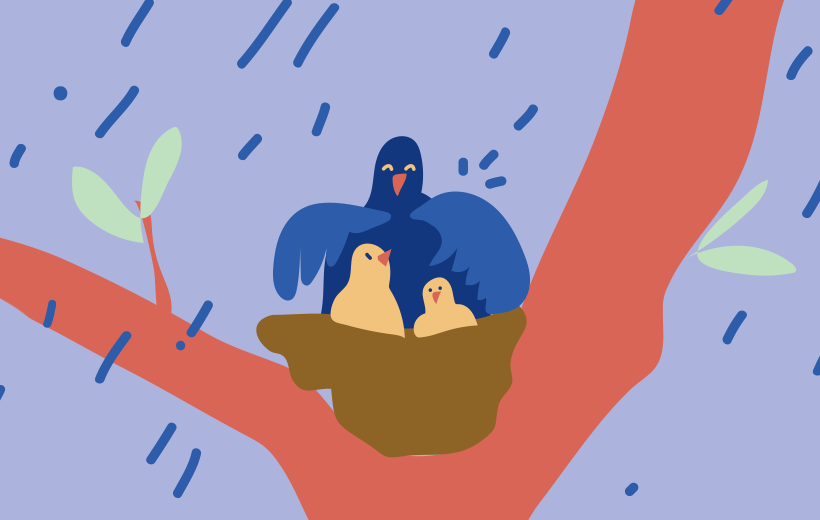Compassion: As Natural as Our Heartbeat
By Myoshin Kelley • 3 min read

Listening to the news from around the world, we hear stories of unimaginable loss and hardship – people facing challenges that seem insurmountable, or maybe we are heartbroken for the planet. There are innumerable ways that suffering emerges.
There is a natural response, like a quivering heart, that wants to alleviate distress when we encounter it. As we may know, this is compassion. Mingyur Rinpoche talks about how this quality is “as natural as our own heartbeat.”
We connect with this beautiful quality throughout the day. Every time we move away from discomfort — turning up the thermometer when our home is too cold, eating when we are hungry — we experience a desire to be free of suffering. While we may sometimes confuse this impulse with chasing short-term relief, the wish to alleviate suffering is an expression of our true nature.
Often, when we encounter someone dear to us who is suffering or see images of people in distress, we resonate with the person and experience the pain as if it were happening to us. I know that many times, I actually experience physical pain in my own body when someone describes their physical pain. Although compassion may be present, it is often shrouded by the effects of empathy. We deeply feel the other’s pain, which, in turn, can trigger a host of emotional responses that can cause feelings of anxiety, fear, and depression. This can very quickly deplete our energy. We may lose any sense of connection and care, becoming lost in our own emotional response or simply too tired to feel. This experience of empathy is often confused with compassion.
“When compassion is infused with awareness, love, and wisdom, it is dynamic, trustworthy, and forever humble. ”
— Myoshin Kelley
It is not uncommon for people working in caring professions to experience exhaustion when they face suffering every day. Constant exposure to life’s trials is challenging. However, by making a simple shift from feeling the pain to embracing an open-hearted response to alleviating suffering, we can touch into the majesty of compassion, which uplifts rather than drains us.
Compassion doesn’t have to be a grand gesture — it can be as simple as holding a friend’s hand, listening as someone speaks, or extending kindness to ourselves when we encounter a difficult situation. Compassionate action doesn’t carry with it the expectation of results but is based on the courage of the heart to meet the circumstances with kindness and care and doing what we can.
Compassion has a support team and never stands alone. It is infused with awareness that allows our hearts to be open and steady. When we feel connected, kindness naturally arises. With wisdom, we can see what’s happening clearly; we don’t try to do the impossible but see what we can do to meet the situation. When compassion is infused with awareness, love, and wisdom, it is dynamic, trustworthy, and forever humble. It is deeply aware of the magnitude of suffering but not deterred by it.
When we feel that empathetic pull, we can appreciate the connection it brings and then shift to that movement of the heart to alleviate the pain. As we do, we switch channels in our brain to connection, care, and kindness. It’s really important for us to know and recognize the difference between the two as empathy will have us closing off to suffering, going numb or burning out, and feeling a need to protect ourselves. Compassion, on the other hand, invites us to stay connected, listen, and be responsive. It uplifts our hearts, energizes us, and reminds us that we are never alone.
In our daily lives, we can explore the power of compassion in simple ways. Looking at the effect in our own minds when we lend a helping hand, extending beyond our limited sense of self, we can see the impact in others when a smile breaks the clouds of hard times. Moment by moment we can uplift our hearts and those around us as the effects of compassion ripple out into the world.
As Matthiew Ricard says, “Compassion is nothing else than love applied to suffering.” In this way, we don’t turn our back on what distresses us by finding the nobility of heart to love in the midst of darkness.
February 2025

Myoshin Kelley is a long-time meditator who shepherded the development of Tergar International. Myoshin oversaw the development of Tergar groups and the training of community leaders. Myoshin lives with her husband Edwin Kelley on the Sapphire Coast of New South Wales, Australia, and they continue to serve Tergar, actively supporting Mingyur Rinpoche’s students as instructors.
.
Learn meditation under the skillful guidance of world-renowned teacher Yongey Mingyur Rinpoche at your own pace.


If we’re coping with a heavy, complicated problem, we’re often too busy to feel lonely. But sometimes, loneliness itself becomes our major problem. What’s happening is that our monkey mind is zooming in on the feeling, exaggerating it. Sometimes we think, “I don’t really have any good friends,” when what we really mean is we…

“Mindfulness meditation” is omnipresent these days. Some of these programs are based on traditional meditation practices, others are what you might call “New Age,” and others have been invented out of whole cloth. There exists at least one program claiming it will get you enlightened in seven days! But is mindfulness the same thing as…

“When you arrive in Nepal, things tend to work out one way or another,” said Anna, a bubbly 33-year-old who makes her home in Melbourne.
If you enjoyed reading our articles, please join our mailing list and we’ll send you our news and latest pieces.